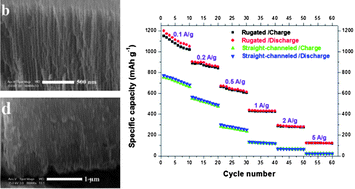Rugated porous Fe3O4 thin films as stable binder-free anode materials for lithium ion batteries†
Abstract
Rugated porous Fe3O4 thin films were synthesized by a facile multi-pulse electrochemical

Maintenance work is planned for Wednesday 1st May 2024 from 9:00am to 11:00am (BST).
During this time, the performance of our website may be affected - searches may run slowly and some pages may be temporarily unavailable. If this happens, please try refreshing your web browser or try waiting two to three minutes before trying again.
We apologise for any inconvenience this might cause and thank you for your patience.
* Corresponding authors
a
Department of Physics and Materials Science, City University of Hong Kong, 83 Tat Chee Avenue, Kowloon Tong, Hong Kong
E-mail:
yangli@cityu.edu.hk
Fax: +852 3442 0538
Tel: +852 3442 7810
b Centre for Functional Photonics, City University of Hong Kong, 83 Tat Chee Avenue, Kowloon Tong, Hong Kong
c College of Chemistry and Chemical Technology, Central South University, Changsha, Hunan, P.R. China
d Department of Micro-Nano Materials and Devices, South University of Science and Technology of China, Shenzhen, Guangdong, P.R. China
Rugated porous Fe3O4 thin films were synthesized by a facile multi-pulse electrochemical

 Please wait while we load your content...
Something went wrong. Try again?
Please wait while we load your content...
Something went wrong. Try again?
H. Cheng, Z. Lu, R. Ma, Y. Dong, H. E. Wang, L. Xi, L. Zheng, C. K. Tsang, H. Li, C. Y. Chung, J. A. Zapien and Y. Y. Li, J. Mater. Chem., 2012, 22, 22692 DOI: 10.1039/C2JM34373H
To request permission to reproduce material from this article, please go to the Copyright Clearance Center request page.
If you are an author contributing to an RSC publication, you do not need to request permission provided correct acknowledgement is given.
If you are the author of this article, you do not need to request permission to reproduce figures and diagrams provided correct acknowledgement is given. If you want to reproduce the whole article in a third-party publication (excluding your thesis/dissertation for which permission is not required) please go to the Copyright Clearance Center request page.
Read more about how to correctly acknowledge RSC content.
 Fetching data from CrossRef.
Fetching data from CrossRef.
This may take some time to load.
Loading related content
